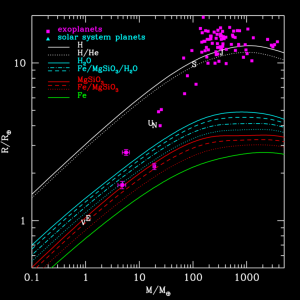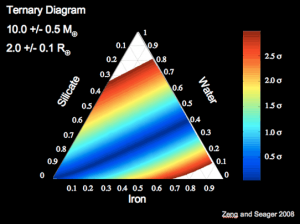Exoplanet Interior Composition
The goal in studying exoplanet interiors is to learn what individual exoplanets  are made of, and even what their internal structure might be. Professor Seager’s work has focused on the mass-radius relationships for exoplanets of a wide range of compositions and masses. Prof. Seager and colleagues. Exoplanet researchers have realized that there are fatal limitations to uncovering the interior composition of an exoplanet because only the mass and radius can be measured—no other information about the interior. This deadlock can be slightly aided in the future when enough exoplanets are found to do statistics, or possibly when molecules can be detected in super-Earth atmospheres in the future.
are made of, and even what their internal structure might be. Professor Seager’s work has focused on the mass-radius relationships for exoplanets of a wide range of compositions and masses. Prof. Seager and colleagues. Exoplanet researchers have realized that there are fatal limitations to uncovering the interior composition of an exoplanet because only the mass and radius can be measured—no other information about the interior. This deadlock can be slightly aided in the future when enough exoplanets are found to do statistics, or possibly when molecules can be detected in super-Earth atmospheres in the future.
To download a MATLAB code to compute your own ternary diagrams for a super Earth of a given mass and radius: View Page
Selection of Prof. Seager’s most significant papers on exoplanet interiors
 Explanation of why the mass-radius relationships for planets of any composition are similar:
Explanation of why the mass-radius relationships for planets of any composition are similar:
Seager, S., Kuchner, M., Hier-Majumder, C. A., & Militzer, 2007, “Mass-Radius Relationship for Solid Exoplanets”, ApJ, 669, 1279-1297.- Carbon planet prediction. This paper was rejected from the ApJ and Marc and I moved on to other things. We decided to let the paper live on Astro-ph:
Kuchner, M. & Seager, S., Extrasolar Carbon Planets, arXiv:astro-ph/0504214.
